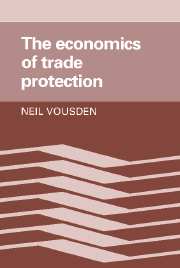Book contents
- Frontmatter
- Contents
- Preface
- Acknowledgements
- I PROTECTION WITH COMPETITIVE MARKETS
- 1 Basic international trade theory
- 2 Protection for a small country
- 3 Import quotas and tariffs: Some other issues
- 4 Protection for a large country
- II PROTECTION AND IMPERFECT COMPETITION
- III THE POLITICAL ECONOMY OF PROTECTION
- IV REDUCING PROTECTION
- APPENDICES
- Notes
- References
- Index
3 - Import quotas and tariffs: Some other issues
Published online by Cambridge University Press: 18 December 2009
- Frontmatter
- Contents
- Preface
- Acknowledgements
- I PROTECTION WITH COMPETITIVE MARKETS
- 1 Basic international trade theory
- 2 Protection for a small country
- 3 Import quotas and tariffs: Some other issues
- 4 Protection for a large country
- II PROTECTION AND IMPERFECT COMPETITION
- III THE POLITICAL ECONOMY OF PROTECTION
- IV REDUCING PROTECTION
- APPENDICES
- Notes
- References
- Index
Summary
In the previous chapter we established the result that in a static competitive economy, a tariff and an import quota are equivalent in the sense that a tariff yielding the same domestic price as the quota also yields the same level of imports and output and the same deadweight loss to the community. Given such apparent equivalence, it is reasonable to conclude that it does not matter whether tariffs or quotas are used to protect output or restrict imports.
Certainly there are situations in which the equivalence of the two policies can be used to deduce interesting and relevant results. One such case is the use of trade restrictions to constrain the imports of a class of heterogeneous commodities (e.g. automobiles). This problem was considered in the previous chapter for the case of tariffs. In Section 3.1, we shall exploit the equivalence of tariffs and quotas to consider the effects of an import quota applied to such a class of commodities. Of particular interest is the way in which quotas on the volume of imports shift the composition of imports towards more expensive items.
Despite the usefulness of equivalence in deriving such results, it is now well known that tariffs and quotas are generally not equivalent in most situations beyond the static competitive model. In particular, if there is monopoly in the protected sector or if the policies are imposed by larger countries involved in a trade war, it will matter very much which policy is used. These cases are taken up in Chapters 5 and 4, respectively. Even in the simple case of a small competitive economy, equivalence breaks down in a number of important cases.
- Type
- Chapter
- Information
- The Economics of Trade Protection , pp. 60 - 83Publisher: Cambridge University PressPrint publication year: 1990



